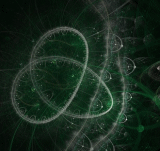John47
There is a lot of talk about strings and their properties but I've not seen anything on how they are created and from what.
As I understand it, a string vibrates and depending on it's frequency can appear as one of many sub atomic particles.
But how does one come into existence and what determines it's frequency.
I'm a vibration analysis engineer working on machinery, so understand low frequency vibration quite well and I'm wondering about this scenario ?
1
In machine vibration, if you hit (impact) a structure it rings at all it's natural frequcies because the impact is short and contains force across a wide range of frequencies.
If you put a rubber cover on the hammer, limiting it's range of frequency (lowering the peak and extending the time of impact) to just include the first natrual frequency of the structure, you will only excite this one frequency significantly.
So here we have a way of creating strings with their lowest natural frequency excited by controlling the "suddenness" of their creation.
In the standard root (K/M) formula for machines they would have an infinite frequency as they have no mass. Is this where the idea of "tension" comes in to provide a range of possible frequencies.
2
But before string creation there is nothing to "hit" so how do they appear ?
Is there a probability field from which they just "spring" when monentarily Pr =1 at a point ?
Is the time it takes to appear the thing that controls their frequency ?
Can they have multiple frequencies ?
3
How long can a string last ?
I deal with mass, stiffness and damping in real world machines, but I'm assuming strings don't have mass, but possibly do have stiffness and damping.
If they had no internal or external damping the vibration could continue forever.
In particle accelerators we see sub atomic particles (and therefore strings) appear after collisions and then disappear.
I can see that the impact energy can be the creator of the string and it's characteristic frequency, but why does it disappear so quickly ?
Any thoughts to share ?
Cheers
John
As I understand it, a string vibrates and depending on it's frequency can appear as one of many sub atomic particles.
But how does one come into existence and what determines it's frequency.
I'm a vibration analysis engineer working on machinery, so understand low frequency vibration quite well and I'm wondering about this scenario ?
1
In machine vibration, if you hit (impact) a structure it rings at all it's natural frequcies because the impact is short and contains force across a wide range of frequencies.
If you put a rubber cover on the hammer, limiting it's range of frequency (lowering the peak and extending the time of impact) to just include the first natrual frequency of the structure, you will only excite this one frequency significantly.
So here we have a way of creating strings with their lowest natural frequency excited by controlling the "suddenness" of their creation.
In the standard root (K/M) formula for machines they would have an infinite frequency as they have no mass. Is this where the idea of "tension" comes in to provide a range of possible frequencies.
2
But before string creation there is nothing to "hit" so how do they appear ?
Is there a probability field from which they just "spring" when monentarily Pr =1 at a point ?
Is the time it takes to appear the thing that controls their frequency ?
Can they have multiple frequencies ?
3
How long can a string last ?
I deal with mass, stiffness and damping in real world machines, but I'm assuming strings don't have mass, but possibly do have stiffness and damping.
If they had no internal or external damping the vibration could continue forever.
In particle accelerators we see sub atomic particles (and therefore strings) appear after collisions and then disappear.
I can see that the impact energy can be the creator of the string and it's characteristic frequency, but why does it disappear so quickly ?
Any thoughts to share ?
Cheers
John


